Wendy Roberts
At the meeting of the Local History Group on 16 November 2017, Wendy Roberts talked about contemporary sources including newspapers which described experiences of Trumpington men and women in World War 1. Wendy was assisted by Andrew Roberts, Randall Evans and Edmund Brookes, who read extracts from the papers. The meeting report has been updated with four addenda. Wendy is a retired academic librarian who has been researching Trumpington and the War.
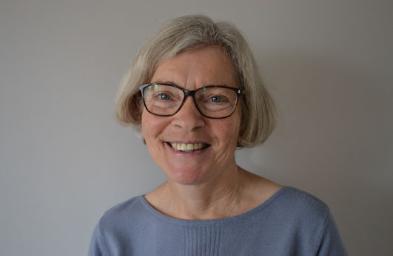
Introduction
In November 2014, a group of us started work on the Imperial War Museum (IWM) Lives of the First World War database, building up records about Trumpington men who had served in the forces. The sources we used were the Village Hall Roll of Honour plaque; military records (aware that 60% of the WW1 service records had been lost in 1940, when a bomb landed on the War Office, where they were stored); information from parish magazines; Ken Fletcher’s ‘Trumpington’s Fallen Heroes of World War I’ booklet; and Howard Slatter’s extensive Trumpington families’ database.
However, this article is primarily based on information gathered from newspapers at the Cambridgeshire Collection and the British Newspaper Archive database. These findings from newspapers give an idea of the recruitment of the Trumpington men and their military careers and also of war time activities of older men and some women of Trumpington.
Recruitment
This photograph is of six Cambridge Boys, capturing a quiet moment at the Front. It was sent from France in December 1915 and is of members of ‘A’ Company, 1st Cambridgeshire Regiment.
It includes Albert Mynott of Trumpington (front right). He lived with his parents next to the Coach and Horses, now the Wok ‘n’ Grill.
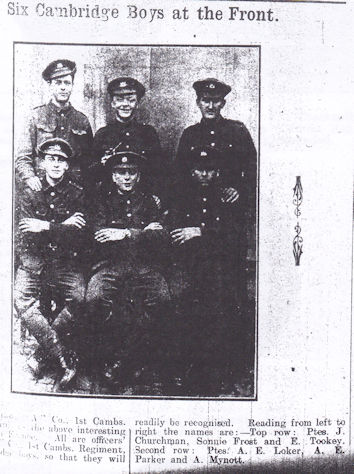
Great Britain declared war on Germany at 11 o’clock at night on 4th August 1914. Lord Kitchener was appointed Secretary of State of War. Ten days later there was an item in the Cambridge Independent Press (Friday 14 August 1914):
On Lord Kitchener’s Appeal. For 100,000 Men. And the formation of Second Regular Army. Lord Kitchener wanted a larger fighting force. The item described early plans for Cambridgeshire. A County Recruiting Campaign proceeded ….
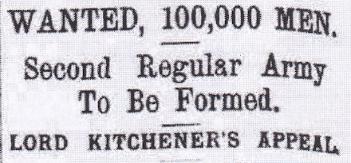
This involved a round of recruitment meetings in places such as Cambridge, Newmarket, Grantchester and Trumpington, and detailed accounts were published.
The meeting in Trumpington was held in the Village Hall on 24th August 1914. Men in the village between the ages of 19 and 30 had been invited to attend. In summary of the meeting, rousing speeches were given by Mr Vinter, Major Morley, Lieutenant Chaplin and Colour Sergeant Ranson. It was stated Trumpington had a population of 720, of whom 68 to 70 men came within the ages of 19 and 30 years and hence eligible for Kitchener’s Second Army. Mr Vinter said he thought that it was going to be a long war. Colour Sergeant Ranson, of the Corn Exchange Recruiting Station, gave particulars of the services, and the procedure upon and immediately after enlistment. He said that a man was free to join what regiment he wished, providing he was up to the standard in that regiment. They were not forced to join anything but what they pleased. … An appeal was made for recruits after the meeting, and six applications were made for enlistment.
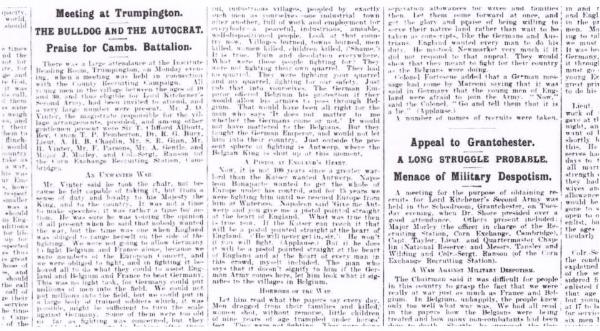
Lists of men who joined up were published in the Cambridge Chronicle and Cambridge Independent Press and these are the Trumpington men I found among the first who enlisted at the Corn Exchange from August 1914.
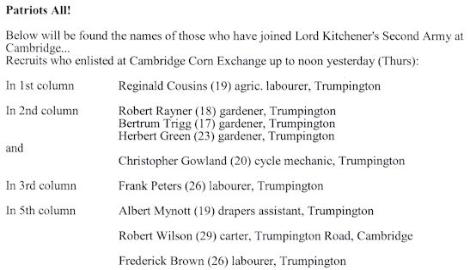
The position in the list probably indicates the order in which they enlisted.
1st column:
Reginald Cousins (19) agricultural labourer
2nd column
Robert Rayner (18) gardener
Bertrum Trigg (17) gardener
Herbert Green (23) gardener
Three gardeners, including Mrs Audrey King’s father, Robert Rayner, probably enlisted together. Bernard Trigg was just 17 years old: young men could join the Special Reserve at 17 yr to receive some military training until they were older and ready for general and foreign service.
Christopher Gowland (20) cycle mechanic
Christopher Gowland also appeared under the ‘Roll of Honour of Members of the Cambridge Town Silver Prize Band’: 15 members were listed including “Private C. Gowland, euphonium, 7th Suffolk Regt., in France”. ( Cambridge Independent Press , Friday 17 September 1915, p. 8.)
3rd column
Frank Peters (26) labourer
5th column
Albert Mynott (19) draper’s assistant
Robert Wilson (29) carter
Frederick Brown (26) labourer
Several of the above men are referred to again in this article.
Each week, lists of men who had recently enlisted at the Cambridge Corn Exchange continued to be published. For example, the list on 20 November 1914 had four Trumpington names:
Anthony Isaacson (23) miller, Trumpington
Frederick Chamberlain (21) gardener, Trumpington
William Flack (23) milkman, Trumpington
William Sotherton Parker (19) gardener, Trumpington
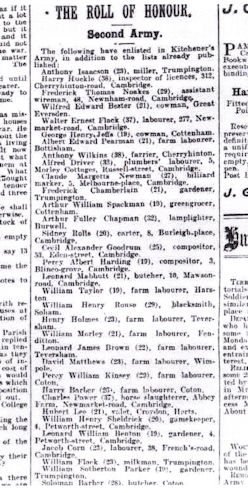
The ‘District News’ page of the Cambridge Chronicle, 27 November 1914, had an update about recruiting.
Recruiting – This is proceeding briskly here now, and on Monday several of our young men journeyed to London, and we understand some of them were accepted for the R.F.A. [Royal Field Artillery] … Hurrah Trumpington!

In addition to the well known posters such as ‘Britons – [Lord Kitchener] Wants You’, cartoons in newspapers were used to encourage recruitment. Cartoons were published even on Christmas Day 1914.
Britons!! When your country is in danger. The Post of Honour is in the Firing Line. Enlist today…
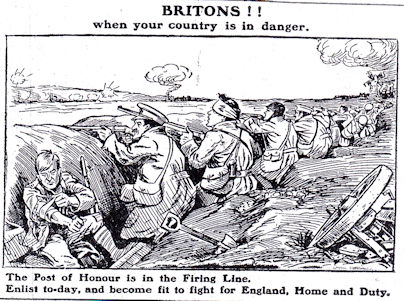
There was a front page announcement on 15 January 1915:
Your King & Country need another 100,000 men.
Terms of service – extension of age limit – now age on enlistment 19 to 38.
Minimum height 5’ 4” …
Enlist for the duration of the War …
(The height restriction had been raised from 5’ 3” to 5’ 6” when authorities could not cope with the early flood of recruits, now it was being reduced to 5′ 4”.)
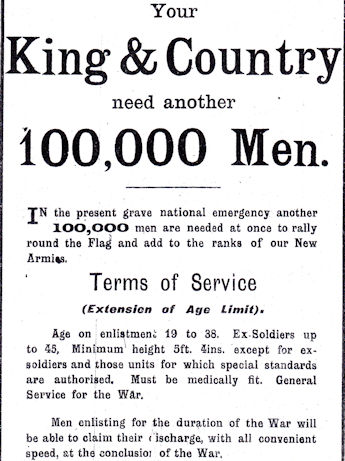
On 5 February 1915, the Cambridge Chronicle had an update on local recruitment.
Recruiting. Recruits still continue to go from this village. The number has reached fifty.
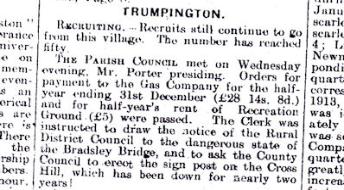
The report also had evidence that normal activities continued in the village: Parish Council meeting report – 2 payments due and Clerk was instructed to draw the notice of the Rural District Council to the dangerous state of the Bradsley Bridge [sic] and to ask the County Council to erect the sign post on the Cross Hill, which had been down for nearly two years!
(Brasley Bridge was built in 1790, rebuilt 1952, rebuilt again 2015 causing inconvenience when the road to Grantchester was closed for a long time. By coincidence the War Memorial was later erected on Cross Hill.)
Active Service
On 18 September 1914, the Cambridge Chronicle had a list of Cambridgeshire men at present on active service. These were chiefly Reserve men who had been called up.
Trumpington: Walter E. Peters (retired from the services hence a Marine Reserve); Herbert Chapman (compositor at Cambridge University Press, member of the Territorial Force and mobilised with the Cambridgeshires); George F. Utteridge; Ernest Hay.
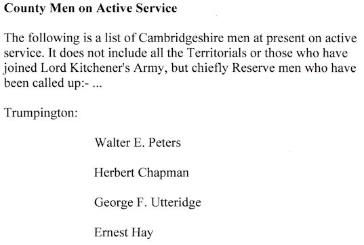
The Cambridge Chronicle on 22 January 1915 had a report about Trumpington Men Home on Leave.
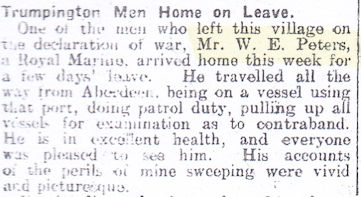
“One of the men who left this village on the declaration of war, Mr W. E. Peters, a Royal Marine, arrived home this week for a few days’ leave. He travelled all the way from Aberdeen, being on a vessel using that port, doing patrol duty, pulling up all vessels for examination as to contraband. He is in excellent health, and everyone was pleased to see him. His accounts of the perils on mine sweeping were vivid and picturesque.”
We have examples of ‘Letters from the Front’ published in newspapers. Here are three extracts from letters, sent to parents.

April 1915, Private Albert Mynott, of the ‘A’ Company, 1st Cambridgeshire Regiment, in a letter to his mother, says: …
“We had a taste of battle on Sunday night, and I am glad to say that all from Trumpington are quite safe. We were in the trenches all day Sunday, and about 4.30 the Germans began to shell us. The shells fell like rain, and we had to retreat into another trench, and there we were firing all night until we were relieved early on Monday morning. We have lost several men, but the Germans lost a lot. It is a sight to see all the houses and churches knocked to pieces. We are now having a few days’ rest a decent way from the firing line, and we are glad of it. The parcels I had came just right, for you see we were hungry after being in the trenches two nights. I am glad to say I escaped unhurt. Three of our chaps had narrow escapes. Bullets passed through their hats and just grazed their heads, and one had his rifle smashed in his hands.” Source: Cambridge Independent Press, Friday 2 April 1915, p. 6.
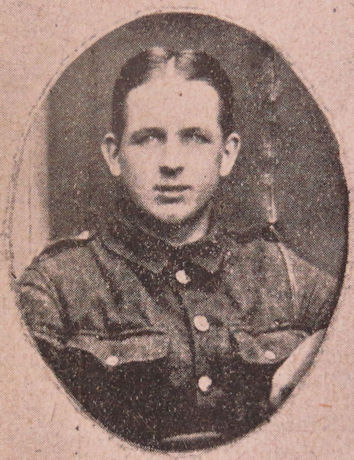
PTE CRACKNELL IN HOSPITAL
May 1915, Private Frank Cracknell, also of the 1st Cambridgeshire Regiment, writes from No. 2 Canadian Hospital in France as follows:
…
“I have been admitted into hospital, slightly wounded in the thumb and leg by shrapnel, but I am getting on well. There are several more young fellows of my Company in the same hospital. They are wounded, but they are getting on very well. It happened that on a Tuesday night we were sent out trench digging, and had just started work, when the shell came bursting in amongst us.” Source: Cambridge Independent Press , Friday 14 May 1915, p. 6.
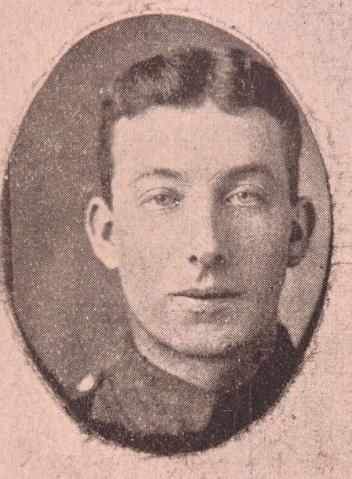

24 October 1915, Letter from Bombardier Bertie King, Royal Field Artillery, Attached Brigade Headquarters, British Expeditionary Force. To Mr & Mrs King, North Cottage, Trumpington:
“Dear Mother and Father, – Just a few lines to let you know that I am in the best of health. You will see by above address that I am attached to the Brigade Headquarters for the time being, as mounted orderly. I have to carry despatches about. The job is all right, but the worst of it is we are likely to be called out any moment of the night. It is all right riding about; one thing you can see what is going on, but you must not get in the way of the bullets! The Germans blew up a mine under one of our first line trenches to-day, and of course they had to use some of their gas. I saw some of our chaps brought in. They must have been in dreadful agony. One thing being in the artillery, when they use gas you do get a chance to get your helmet on in time. I see by the ‘Chronicle’ you sent me that you have had the Zeps over London again, and rather a lot of lives lost. Have not received parcel yet, but expect I shall receive it tomorrow. Please do not forget to send ‘Chronicle’ every week, as I like to read a bit of local news.” Source: Cambridge Chronicle , 3 November 1915 p. 6.
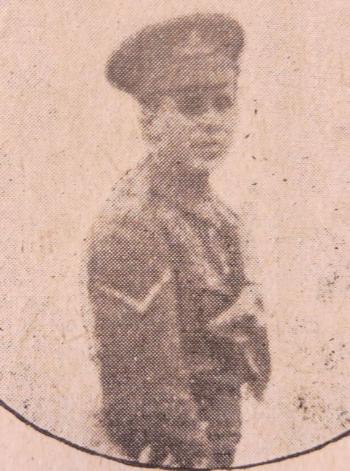
Volunteer Training Corps
Leaving the younger men of Trumpington for the moment, what about the older men?
On 27 November 1914, the Cambridge Chronicle had a report that a company of ‘old crocks’ – i.e. men over the military age – will be organised. Rumoured that an excellent site has been kindly offered for the purpose of drilling and that a miniature rifle range will be established in the parish for use of members. This was to be a Volunteer Home Defence Militia.
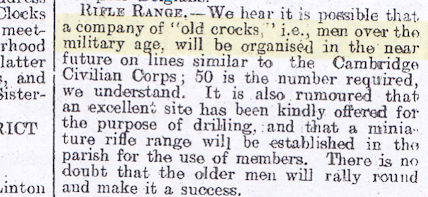
On 11 December 1914, it was said that a Voluntary Training Corps is in course of formation at Trumpington. The Vicar (Dr Bury) presided at meeting at the Institute. … Mr Foster [of Anstey Hall] offered to provide a rifle range and courtyard for training. Members, however, would have to provide their own ammunition. Mr P.R. Robinson [the schoolmaster] was acting as hon. secretary.
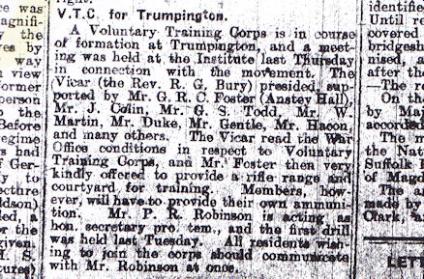
There was an update on 28 May 1915: Volunteer Training Corps – This Corps, affiliated to the Central Association of Volunteer Training Corps, which is recognised by the War Office – has been in training for a period of six months. … There was an appeal for financial assistance to provide uniforms and equipment. … Since its inception nine members have joined His Majesty’s Forces.
[Some young men joined as cadets until old enough to enlist for general.] service.
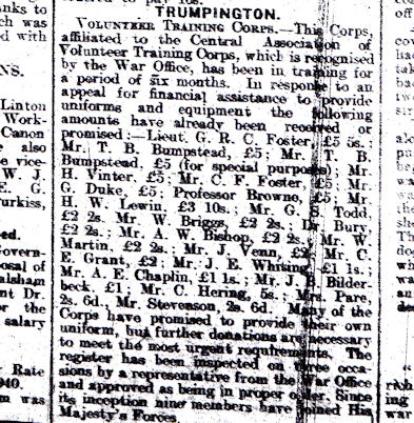
In November 1915, the Cambridge Chronicle included a photograph of members of the V.T.C. outside Anstey Hall. The men were named in the photo caption, including front middle – Lieut. G.R.C. Foster (Pres.); Cadet Instructor Peel; Dr Bury (Vicar, Vice Pres.); P.R. Robinson (Sec.).
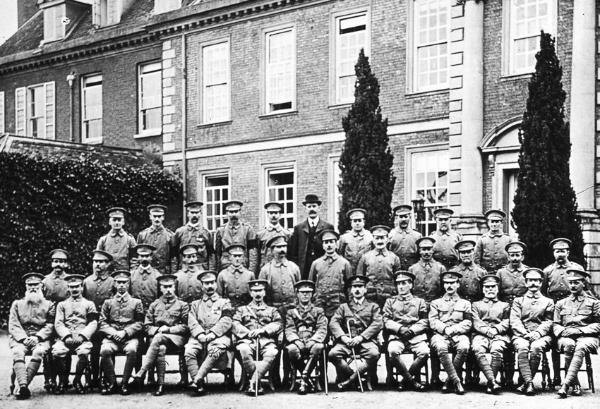
The Voluntary Training Corps was an active group and took part in shooting matches against teams, such as the Suffolk Yeomonry, and also held Inter- Platoon matches. The Cambridge Independent Press published the results of shooting matches – on 25 June 1915 against the MA section of the University Officer Training Corps. The Trumpington V.T.C. team included Dr Bury – Vicar, Percy Robinson – school master, and high scoring Robert Smith (father of Mary Raeburn Smith, who lived on Shelford Road, and did paintings of wild flowers, etc.).
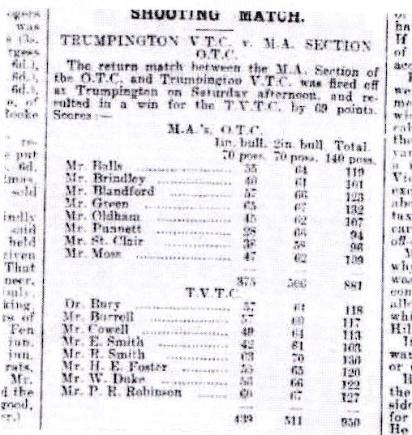
The Trumpington V.T.C. took on a range of duties – a photograph in November 1915 showed members of the Trumpington V.T.C., Patrol No. 3, on duty guarding a railway bridge. It is still possible to see, in Trumpington Meadows Country Park, the position of the railway line and where the bridge crossed the river.
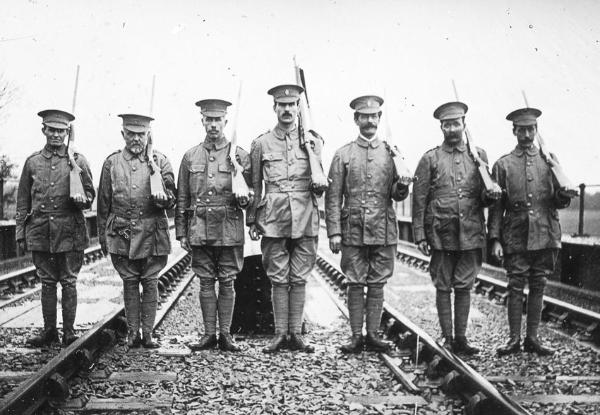
On 16 February 1917, there was a report of another duty, Emergency “Call” on Volunteers. “Yes, they were quite ready. An aeroplane having descended in the district, the police asked for an armed guard to be sent to do duty through the night. Within 20 minutes all the emergency men in the village had been acquainted of the “call” and told to be in readiness, and the first guard in uniform, with arms and ammunition, were ready to proceed to duty, when a message was received stating that their services were not required.” Source: Cambridge Independent Press, Friday 16 February 1917, p. 8.
First Roll of Honour
As the men of military age joined the services, a decision was made to gather their names to be displayed on a board in the parish church.
A year after the start of the war … on 29th August 1915, the Vicar (the Rev. Dr R. G. Bury) unveiled the village Roll of Honour board. The names of sixty-nine Trumpington men were inscribed on the board, which had been erected near the west door of the church.
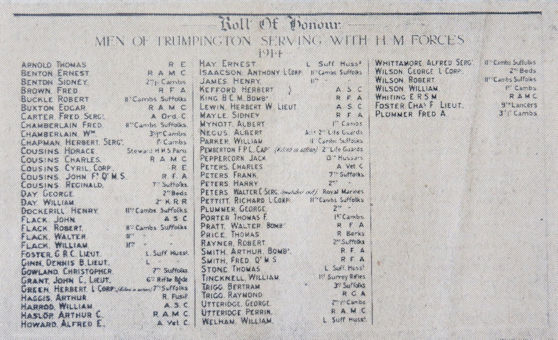
The Vicar read out the names and included were the names of two men who had already fallen in action.
The first was Captain Pemberton, who died in October 1914. He was the Great Uncle of Mr Antony Pemberton.
Captain Pemberton Killed at the Front. First Cambridgeshire Officer to Fall.
“Deep regret has been caused throughout Cambridgeshire by the official news that Captain Francis Percy Campbell Pemberton, of the 2nd Life Guards, only son of Canon and Mrs Pemberton, of Trumpington Hall, was killed in action near Roulers on Monday October 19th. The news was conveyed to members of the deceased officer’s family on Friday evening. His Majesty the King, who is Colonel-in- Chief of the Regiment, and Her Majesty the Queen, have telegraphed their deepest sympathy to Canon and Mrs Pemberton.
Captain Pemberton, who was 29 years of age, was educated at Trinity College, Cambridge. He entered the Army in 1907, and received his captaincy in August last. In May 1912 he was seconded from his regiment (the 2nd Life Guards) to take up duties of cavalry instructor to the Oxford and Cambridge Officers’ Training Corps. The appointment would have expired next March, but on the declaration of war he was recalled to his regiment.
…
Capt. Pemberton is the first Trumpington man who has fallen in the war. He is also the first Cambridgeshire officer who has died for his country in this great struggle.”
Source: Cambridge Chronicle , 30 October 1914.
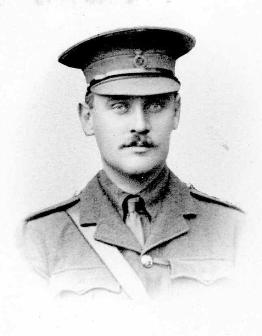
The second was Herbert Green, the gardener, who had enlisted with two of his colleagues at the Corn Exchange in August/September 1914. He died in July 1915.
Private Herbert William Green, of the 7th Suffolks, who died of wounds received in action in France.
“Pte. Herbert William Green, of the 7th Suffolks, who died of wounds received in action in France on July 20th. Pte. Green, who was under-gardener to Lieut. G. R. C. Foster, of Anstey Hall, answered to his country’s call in the early days of the war. He was of a happy disposition, and was a general favourite.” Source: Cambridge Independent Press, Friday 27 August 1915, p. 6.
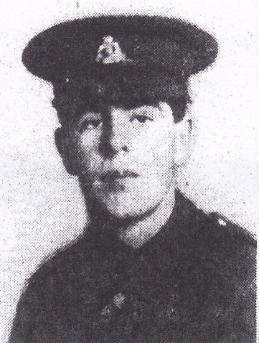
A week later, at the church service on Sunday 5th September 1915, news was given of another soldier’s death:
Private Arthur Charles Haslop, of Trumpington.
“Private Arthur C. Haslop, Royal Army Medical Corps, 54th East Anglian Casualty Clearing Station, was on board the Royal Edward when the transport was torpedoed in the Aegean on 13 August. He is reported to be missing and is believed to have been drowned. Son of Mr and Mrs Haslop, of 47 Alpha Terrace, Trumpington. He was employed as a gardener at Trumpington Hall for about nine years. Although rejected at his first attempt to join the forces on account of his height, he was successful on his second application. Haslop was one of the first batch of men in Cambridgeshire to join the Voluntary Aid Detachment when the organisation was started. He was very keen and obtained the medallion of the St. John Ambulance Association for proficiency. His general disposition and willingness to help in any organisation pertaining to the welfare of the village made him a great favourite.
A touching reference to his death was made by the Vicar in church on Sunday last and at the end of the service the Dead March was played. Haslop was 27 years of age.” Sources: Cambridge Independent Press , Friday 10 September 1915, p. 5; Cambridge Chronicle , 17 September 1915, p. 8.
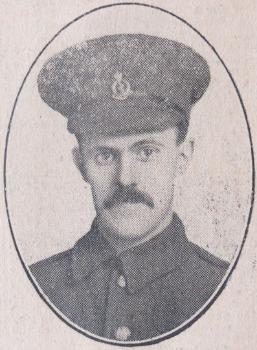
Chesterton Military Service Tribunals
Lord Kitchener’s campaign had encouraged over one million men to enlist by January 1915. But this was not enough to keep pace with mounting casualties. Conscription was introduced in 1916.
Military service tribunals were established at which men could apply for exemption on various grounds such as involved in work of national importance, business or domestic hardship, medical unfitness, and conscientious objection.
Reports of appeals made to the Chesterton Tribunal were published and some give a surprising amount of detail about local businesses. The first example from June 1916 covers Sheldrick’s sawmill of Alpha Terrace.
“Messrs Sheldrick and Son, of Trumpington, applied for exemption for three men. The first was Mr A. W. Sheldrick, the junior partner of the firm, circular saw sharpener, circular sawyer, etc.. Mr A. V. Clements stated the case, and said the firm was engaged in making ammunition box ends, partitions and ammunition slings, etc. and had a contract for supplying coffin boards to the undertaker who supplied all the military coffins in Cambridge. Mr Sheldrick, junior. had the supervision of the workshop. – Six months’ exemption was granted. The second man was George Chapman, employed in breaking up mill timber, and the third was Richard J. Wilson, the only skilled timber feller and hauler in the employ of the firm. – Chapman was granted conditional exemption and Wilson was granted a month’s exemption.” Source: Cambridge Independent Press , 16 June 1916, p. 6.
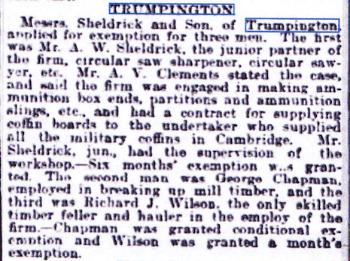
Reports from January 1917 give some information about Anstey Hall Farm and Trumpington laundries, plus a role of the Volunteer Training Corps.
“Mr Foster, Trumpington, applied for Robert Wilson, married, four children, ploughman and general labourer on a farm of 470 acres, on which are nine men and a boy. There are five ploughmen to 12 working horses. – Mr A. V. Clements stated the case – Exemption was given for six months, conditional on the man joining the Volunteer Force.
John Charles Galley, carrier and slaughterman, Trumpington, applied on business grounds. — Mr A. V. Clements supported the application, and stated that the applicant carried for six laundries. –Exemption was granted for six months, conditional on his joining the Volunteer Force.” Source: Cambridge Independent Press , Friday 19 January 1917, p. 6.
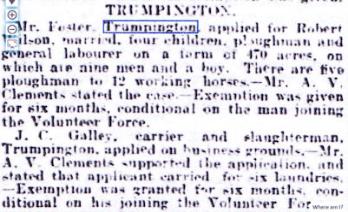
In John Galley’s next appeal, it was reported that there were 27 laundries in Trumpington. Source: Cambridge Independent Press , 17 August 1917, p. 3.
News of Active Service
By 1917, many Trumpington men were on active service abroad and a number had fought in the Third Battle of Ypres, Passchendaele [31st July – 6 November 1917].
TRUMPINGTON
News was received in Trumpington by Mrs Metcalfe of 6 North Terrace, October 1917.
Private Michael Charles Metcalfe
“News was received yesterday (Thursday) by Mrs M. C. Metcalfe of 6 North Terrace, Trumpington, that her husband, Pte Michael Charles Metcalfe, Cambs Regiment, had been killed during an attack in France on Wednesday, September 26th. The following letter announcing the death has been received from Corporal A. H. Merry of Cherryhinton, Cambs Regiment: “Dear Mrs Metcalfe. It is with deep regret and heartfelt sympathy that I write these few lines to inform you of your dear husband’s death. He was killed by a sniper during an attack which we made on September 26th. I was standing beside him at the time. I am quite certain that he suffered no pain. His belongings I am sending to you. I can assure you that Charles was a great chum of all in the company and that everyone here will miss him greatly. He was every inch a soldier, and he is now resting in peace with some more of his brave comrades, who have made the great sacrifice. I cannot express to you my sincere sympathy enough, as he and I were the greatest chums, but I trust that God will bear you up under the great strain of your sad bereavement.” Pte. Metcalfe was 32 years of age, and leaves a widow and six children (ages 11 years to 1). Previous to enlistment he was employed as gardener to Mr Hopkinson, Adams Road, Cambridge. Two of his brothers have been killed in the present war.” Source: Cambridge Independent Press, Friday, 5 October 1917, p. 5.
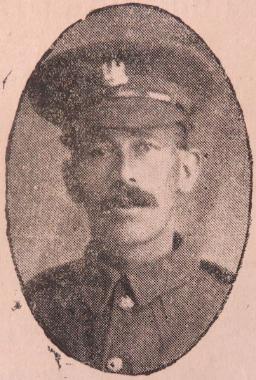
However, not all war news that appeared in the Trumpington section of the newspaper was of reports of loss of life. This item was published on 16 November 1917.
“Official news has been received that Ptes. J. Peters, of the Norfolks, and A. Medhurst, of the Cambs., are reported as missing, the former since October 14th and the latter from September 26th. The relatives of the above will be grateful for any news of them from comrades.” Source: Cambridge Independent Press , Friday 16 November 1917, p. 5.

In May 1918, Mr and Mrs Starr reported news of their son, Allen.
“Pte. A. T. Starr, Suffolk Regt., eldest son of Mr and Mrs A. Starr, of Alpha Terrace, Trumpington, who was reported wounded on the 28th March, has sent a card stating that he is wounded and a prisoner of war in Germany. Writing to Mrs A. Starr, his officer says: “He was acting as my servant at the time, and was wounded in the chest by a piece of shell, but he left me shortly after we dressed him to go to a dug-out. That was the last I saw of him. I trust you will be able to get some better news of him before long, as he was an excellent fellow in every way.” Before the war Pte. Starr was employed by the County Council as a roadman.” Source: Cambridge Independent Press, Friday 10 May 1918, p. 5.
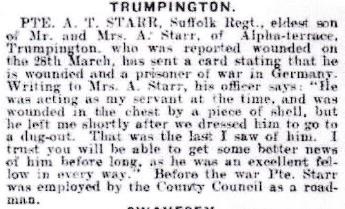
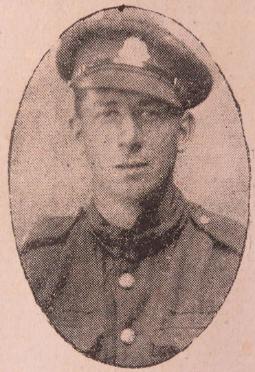
Using the newspapers and other sources, a list of Prisoners of War has been produced.
It includes John Peters and Albert Medhurst, who had been reported missing; and Robert Rayner – previously noted enlisting early at the Corn Exchange with his two colleagues. He was the father of Mrs Audrey King.
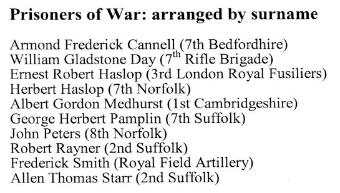
A list of Trumpington men who received Military Awards or Decorations has also been produced, again drawn from various sources.
The list includes Ernest Chapman – brother of Herbert Chapman, compositor, CUP; Reginald Cousins – 19, agric. lab. early enlistment at Corn Exchange; and Albert Mynott – draper’s assistant – enlistment at Corn Exchange 1914 and Letter from the Front.
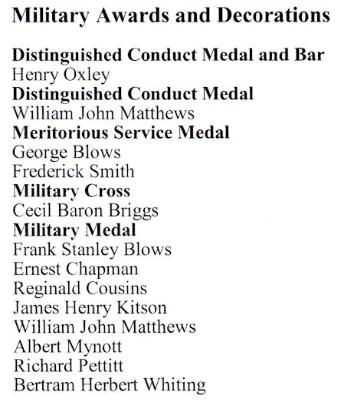
For some of the awards, it is difficult to find the details of the specific act of bravery for which an award was issued but some have been discovered in newspapers.
In November 1917, news was published about Henry Oxley, who was born near Sheffield, moved to Trumpington and married the sister of Walter Peters, the Reservist who had been involved in mine sweeping off the Scottish coast.
“Sergeant-Major H. Oxley of the King’s Royal Rifle Corps, a Walkley man, has been awarded a bar to his Distinguished Conduct Medal. A brave soldier, Sergeant-Major Oxley has had recognition of his valuable services during each of the last three years. In 1915 he was awarded a certificate “for gallant and meritorious service” in holding a trench against the enemy at Hooge; in 1916 he gained the D. C. M. for bravery during an attack by the Germans on a British position, and his bar is awarded for good work done last year – “conspicuous gallantry and devotion to duty in successfully getting up rations under great difficulty. Later, though severely wounded, he refused to go down until the other wounded had been attended to; before leaving, he sent an orderly to the officer with a report on the situation.” Source: Sheffield Evening Telegraph, Saturday 23 March 1918, p. 4.
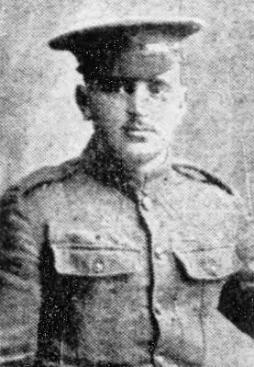
Another account of bravery was published in August 1917.
Albert Mynott, 19, the draper’s assistant, who enlisted very early and whose letter from the Front was quoted above.
“Sergt A. Mynott of the Cambs Regt, son of Mr and Mrs Mynott, of Trumpington, who was severely wounded in the right thigh on July 31st, is now lying in Dunston War Hospital, Northampton. He has been awarded the Military Medal. He had a party of 50 men pushing some deadly gas cylinders on a light railway over a bridge up to the line, when the enemy opened fire as the men were crossing. It was dangerous to leave the cylinders, our own troops might have been gassed. Sergt Mynott rallied the men, who had scattered, and got the cylinders over the bridge out of danger without mishap. Sergt Mynott joined the Forces in August 1914 and has served 2 1/2 years in France. He is 21 years of age.” Source: Cambridge Chronicle , 31 August 1917, p. 8.

Further Rolls of Honour
Two more Roll of Honour boards were unveiled in the parish church and reproduced in the Cambridge Chronicle .
The second Roll of Honour was unveiled in September 1916, listing Men of Trumpington who joined H. M. Forces after August 29 1915, including conscripted men.
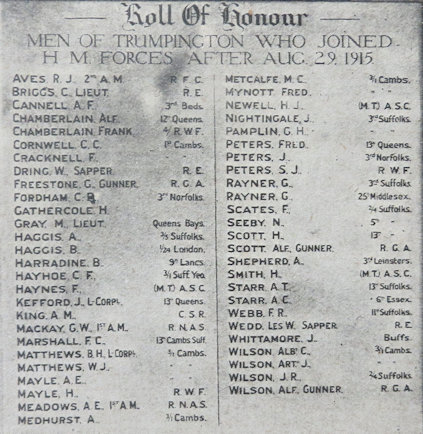
The third Roll of Honour to be placed in Trumpington Church was unveiled in March 1918, with Men of Trumpington who joined H. M. Forces after September 3, 1916.
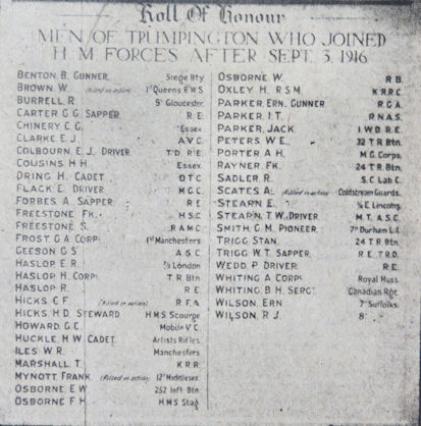
At the end of the War, a single list was produced taking the names from the three Roll of Honour boards plus additional names (including men who had joined H.M. Forces after March 1918). An asterisk* marks those who lost their lives while in service. This is the plaque displayed on the wall in the Village Hall Committee Room.
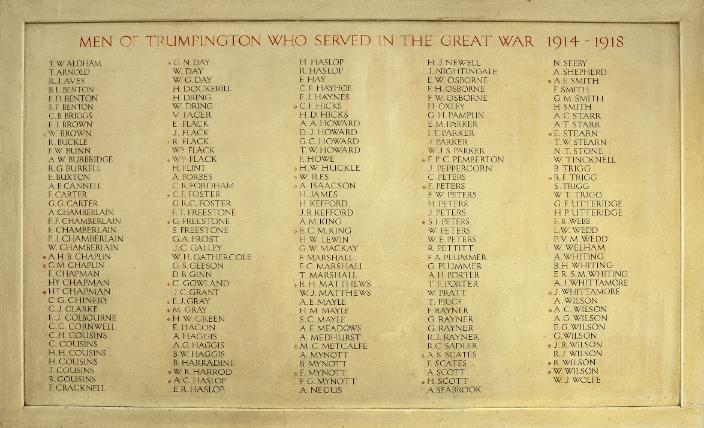
Women and the War
There are no names of women on the Roll of Honour boards but we know that Beatrice Mabel Cousins and Mrs Winifred Edith Chapman joined the Women’s Army Auxiliary Corps: the former served from February 1918 to June 1919 and latter served from May 1918 to December 1919.
There is information about Trumpington women involved with the Red Cross Society Voluntary Aid Detachments (VAD) in events of 1913.
A military parade in June 1913. A parade with the local units of the Territorial Force and National Reserves and the VAD of the Red Cross Society on Parker’s Piece.
The report refers to unregistered women from Trumpington, Cambridge Borough, Fulbourn, etc. (their commandants – Mrs Hartree and Miss Pemberton, of Trumpington).
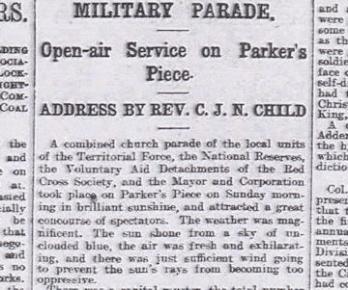
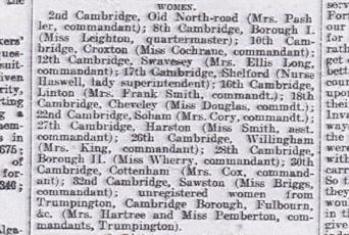
There is also a report of Red Cross Field Days in 1913.
“Trumpington women and Trumpington, Newton, Histon, and Cambridge Borough men also took part, but not as detachments.”
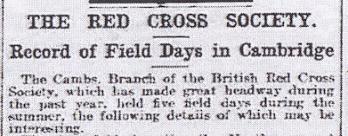
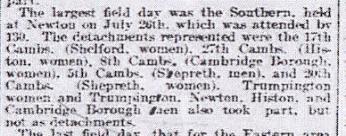
Voluntary workers are mentioned in an August 1914 item describing the early development of the Cambridge military hospital, which developed as the 1st Eastern General Hospital.
“Arrangements for the accommodation of a very large number of wounded in the event of Cambridge being established as a base hospital, are now in a very forward state, and hospital wards, completely equipped, have been fitted up in many of the colleges. A full staff of medical men, nurses, and assistants is in readiness for any emergency.
…Scores of voluntary workers in Cambridge and the county are busy making articles of clothing, etc. for use in hospitals. The Voluntary Aid Detachments are all ready, and have been busily engaged for some time past…”
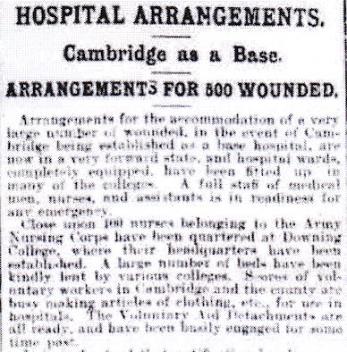
Who were these women? Who were these voluntary workers? I was unable to find information in local newspapers about specific Trumpington volunteers/Red Cross Voluntary Aid Detachment members (VADs). However, I discovered in 2015 that the British Red Cross was in the process of producing a database of World War 1 Volunteers and I was soon able to draw out copies of index cards showing the activities of a previously hidden group of women. Here is a sample of those index cards.
Mrs Ethel Bilderbeck, Bentley Road – A home worker since 1914 doing a great amount of making and mending for 1st Eastern General Hospital.
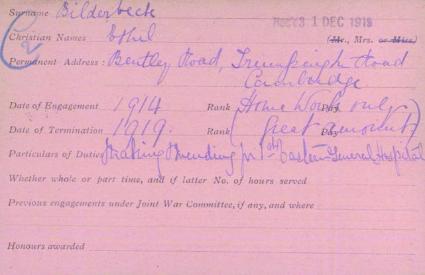
Mrs Eliza Chapman, 4 Alpha Terrace – Nursing since 1914 and meeting convoys at the station, Number of hours served – 1675 hrs (indicated on back of card – nursing at Huntly VAD Hospital, Herschel Rd). Mrs Chapman’s sons were Herbert Chapman, compositor, CUP, Territorial and Cambridgeshire Regiment, and Ernest Chapman, Royal Garrison Artillery – awarded Military Medal.
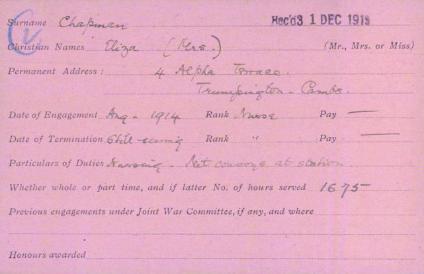
Mrs Grace Harriot Foster, Anstey Hall – Head of Working Party – mending clothes for 1st Eastern General Hospital 17 May 1916 –; Number of hours served – 792 hrs. Several hrs at Red X Depot Camb; Queen Mary Guild Ln; Canteen wk Tadworth.
Mrs Foster’s family: Lieutenant Foster, Suffolk Yeomanry/President of the V.T.C.; VAD Nurse Miss Helen Mary Finch Foster at Shelford Red Cross Auxiliary Hospital; and Lieutenant Charles Finch Foster, (Queen’s Royal) Lancers. Charles was killed in action on 27 March 1918.
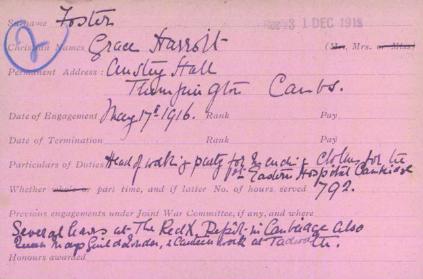
There were cards for 13 members of the Working Party and also index cards for Mrs Rose Mynott, a cook at 1st Eastern General Hospital; Mrs Alice Caroline Browne, a masseuse at Shelford Red Cross Auxiliary Hospital; and other nurses, including Mrs Foster’s daughter, who also worked at Shelford Hospital; also for some men who acted as VAD drivers.
Community Involvement
Newspaper accounts showed that the general population of Trumpington were involved in war related charitable deeds, including support for a family of Belgian refugees.
27 Nov 1914: Belgian Refugees. There is one family of Belgian refugees resident in this place, a house having been taken and furnished for them on [27] Shelford Road. They are Monsieur Latour and family. Practically the whole of the residents in the parish are contributing in some way or other towards the refugee fund which is being raised to assist the poor Belgians.
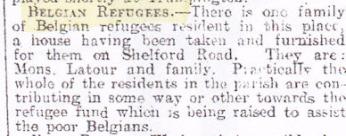
22 Jan 1915: Belgian Refugees. Various schemes for the assistance of these are afloat, and one of the latest and perhaps most useful is a French class promoted by Miss Pemberton, of Trumpington Hall. A Belgian schoolmaster (a refugee) is staying at Great Shelford, and in order to assist him and his family, and at the same time instruct anyone who desires it, a class has been arranged for Thursdays at Trumpington Hall. We understand about 15 attended last week. [This would have enabled Monsieur Latour to earn some money.]
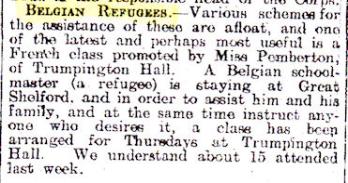
3 Mar 1915: CONCERT. An exceedingly successful concert, organised by Mrs J. Collin, was held in the schoolroom on Wednesday, the proceeds being donated to the Trumpington Belgian Relief Fund. The room was crowded, amongst those present being Monsieur Latour and family, the Belgian guests, for whose benefit the concert was arranged… “The artistes were exceedingly entertaining and the evening opened with the National Anthems of Russia, Belgium and France by Miss Wallis (violin) and Mrs Baillie (piano) …” Source: Cambridge Independent Press , 5 March 1915, p. 8.
There was news of another charitable act on 22 December 1916.
“Christmas Parcels – With the proceeds of the jumble sale held last October, augmented by a collection in church, a parcel has been sent to every man of Trumpington serving with His Majesty’s Forces. The work of organising the distribution was kindly undertaken by Mrs G.R.C. Foster, of Anstey Hall.
The parcels to the men in the Expeditionary Force, to the number of about 60, were comprised chiefly of foodstuffs, consisting of a tin of each of the following: sweets, sausages, pineapple, salmon, potted meat, and soup squares, whilst a pipe was inserted in each, generously provided by Mr G.R.C. Foster.
The parcels were dispatched by order, from Messrs. Hallack and Bond, and a large number have already reached their destination, as each post brings grateful thanks from men in the trenches, showing their great appreciation of the good things. One writes: “It’s very good of the people to think of us boys out here. It’s a very nice parcel indeed, and we’re going to enjoy it together in our dug-out.”
The parcels for men in Great Britain (about 50) vary from those sent abroad, and are being packed by Mrs Foster. Each parcel contains a card, with ‘From the people of Trumpington’ on it.” Source: Cambridge Independent Press , 22 December 1916, p. 8.
End of the War
Finally the end of fighting, with the Armistice on the 11th hour of the 11th day of the 11th month, 1918.
The Treaty of Versailles was signed on 28th June 1919 and, in the UK, 19th July was declared to be Peace Day and a Public Holiday. In London there was a victory parade. The Cambs. Regt. were invited to send a colour party to take part. The end point of the parade was in Whitehall at a monument to those killed and wounded. This was Lutyens’ temporary wood and plaster Cenotaph. It was replaced by the Portland stone Cenotaph the following year.
Peace Day Celebrations were widely held on that day.
On the 7th July the Trumpington Parish Council resolved itself into a committee for the purpose of making arrangements for 19th… It was decided to entertain to a meat tea all returned soldiers and sailors, women who had been in the Forces … They arranged a programme for the day: 10am short thanksgiving service followed by 10.30am cricket match Married versus Single (Singles won); 2pm onwards 15 sports events on the Recreation Ground with children’s tea at 4pm; later about 600 people sat down to a meat tea – “plenty of food, although a little more sugar would have been acceptable”; and, in the evening, the grounds of Trumpington Hall and Anstey Hall were thrown open to the parishioners for dancing. Sources: Cambridge Independent Press , 25 July 1919, p. 9; Cambridge Chronicle , 23 July 1919, p. 12.
Trumpington War Memorial
On Sunday 11 December 1921, the Trumpington War Memorial was unveiled. A detailed report in the newspaper described the church service and subsequent procession and unveiling of the Trumpington war memorial at Cross Hill.
In the church, pews in front of the ex-Service men were left empty – in respect for their comrades who had lost their lives during the war. The Lord Lieutenant, Mr Charles Adeane, performed the unveiling and Captain Dennis Ginn read the names of the 36 men commemorated on the memorial. A large laurel wreath from the relatives of the fallen was placed on the memorial by Mrs Pemberton (whose only son had been killed in action) and Mr Joseph Wilson (who had lost three sons). The Comrades’ wreath was placed on behalf of ex-Service men by Mr Harry Peters (who had lost two brothers in the war). [Captain Francis Pemberton; and Robert Wilson, one of Joseph Wilson’s sons, and Frank Peters, one of Harry Peters’ brothers, who were on that first list of men enlisting at the Corn Exchange in 1914.]
The Cambridge Town Silver Band had played a slow march for the procession from the church to Cross Hill. Was Christopher Gowland among them, playing his euphonium? No. His name was on the memorial. He had died in a casualty clearing station, in France, three weeks after Armistice.
Source: Cambridge Chronicle , 14 December 1921, p. 8.
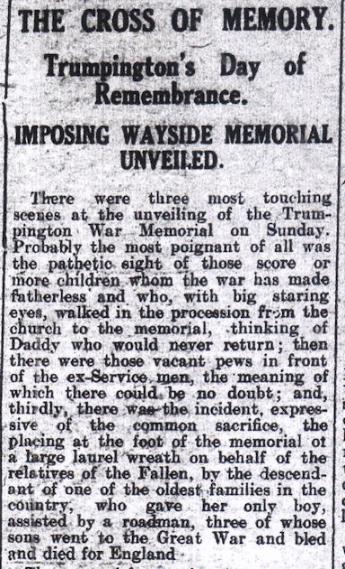
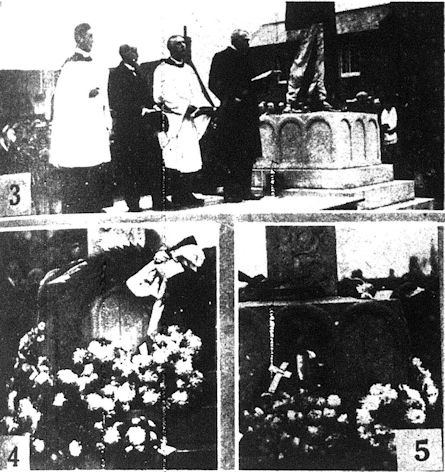
Further information
I hope this has shown how the wider Trumpington Community was involved in war related activities. For more stories, please look at this website, under ‘Subjects’ and ‘World War One’. There is a gateway to the ‘Trumpington Community’ leading to specific records on the IWM Lives of the First World War database.
There are two groups of names at the gateway:-
Group 1 – those of the 189 men who have an entry on the ‘Roll of Honour’ plaque. There are links to ‘IWM Lives’ records for 164 of these men, giving biographical (family and military) information. Unfortunately, although family details are known for most of the remaining 25 men, we have been unable to trace a specific military record for them.
Group 2 – names are of 113 men and women who were not included on the Roll of Honour but who had a strong connection with Trumpington and have been identified as having served during WWI. This group includes the women in the Women’s Army Auxiliary Corps, men and women of the Voluntary Aid Detachment (VAD) service and men of the Trumpington Volunteer Training Corps (VTC).
It is here where answers to the question ‘What did YOU do in the War?’ may be found for Trumpington families.
Many thanks to Edmund Brookes, Randall Evans and Andrew Roberts for their assistance in reading the letters from the Front and other scripts. Also many thanks to Andrew Roberts for editing and reformatting my text to make it suitable for the Trumpington Local History Group website.
See below for:
Addendum 1. Prisoners of War: arranged by date taken as prisoner
Addendum 2. Military Awards and Decorations: with details of award where known
Addendum 3. Names on Trumpington War Memorial: arranged by date of death
Addendum 4. 10 years after the end of WWI, a party of 15 from Trumpington visited the Battlefields with the British Legion
Addendum 1. Prisoners of War: arranged by date taken as prisoner
1916
20 Jul 1916 Robert Rayner (2nd Suffolk); Longueval
1917
19 Jan 1917 Armond Frederick Cannell (7th Bedfordhire); Cambrai/Miraumont, Somme; injured hand
26 Sep 1917 Albert Gordon Medhurst (1st Cambridgeshire); Ypres; head wound
14 Oct 1917 John Peters (8th Norfolk); Poelcapelle
30 Nov 1917 George Herbert Pamplin (7th Suffolk); Cambrai
30 Nov 1917 Frederick Smith (Royal Field Artillery); Cambrai
1918
21 Mar 1918 William Gladstone Day (7th Rifle Brigade); Saint Quentin
23 Mar 1918 Ernest Robert Haslop (3rd London Royal Fusiliers); Fartner?
27 Mar 1918 Herbert Haslop (7th Norfolk); Albert
28 Mar 1918 Allen Thomas Starr (2nd Suffolk); Wancourt; chest wound
Addendum 2. Military Awards and Decorations: with details of award where known
Distinguished Conduct Medal and Bar
Henry Oxley
Sheffield Evening Telegraph , Saturday 23 March 1918, p.4
In 1915 he was awarded a certificate “for gallant and meritorious service” in holding a trench against the enemy at Hooge; in 1916 he gained the D. C. M. for bravery during an attack by the Germans on a British position, and his bar is awarded for good work done last year – “conspicuous gallantry and devotion to duty in successfully getting up rations under great difficulty. Later, though severely wounded, he refused to go down until the other wounded had been attended to; before leaving, he sent an orderly to the officer with a report on the situation.”
Distinguished Conduct Medal
Philip Howard
Cambridge Independent Press , Friday 22 February 1918, p.8
On many occasions he has displayed bold leadership and resource in patrol actions with the enemy, and has at all times set a fine example.
William John Matthews
Cambridge Independent Press , Friday 23 August 1918 p.6
“For conspicuous gallantry and devotion to duty during an attack. When his platoon commander had been killed and his platoon were being pressed back he rallied and led forward 2 sections under heavy machine gun fire, and maintained the position for 36 hours until ordered to withdraw. This prompt and gallant action enabled the whole company to hold its line.”, 9th to 15th April, during the Battle of the Lys, he received a letter of congratulation from the General, and the D. C. M., in addition to which he was promoted to Lieut.
Meritorious Service Medal
George Blows
Cambridge Daily News , Wednesday 19 June 1918, p.3
For work in the Ypres and Cambrai battles towards the close of 1917.
Frederick Smith
Military Cross
Cecil Baron Briggs
Military Medal
Frank Stanley Blows
Cambridge Daily News , Saturday 26 January 1918, p.3
Two Cambridge men, Sergt. G. Brasnett and Pte. Frank Blows, of the 1st East Anglian Field Ambulance, have been awarded Military Medals for gallantry in the Cambrai battle. They cleared wounded from a heavily-shelled area, which was in full view of the enemy and frequently swepted by machine gun fire. They worked for a long period under very trying conditions, and by their dogged determination and splendid example to others every wounded man was cleared safely away. Both Sergt. Brasnett and Pte. Blows had a very exciting experience. They were surrounded by the Germans for about 48 hours and yet succeeded in escaping and getting back into the British lines.
Ernest Chapman
Reginald Cousins
Cambridge Independent Press , Friday 26 July 1918 p.5,
Pte. Reginald Cousins of Trumpington has also won the Military Medal for good deeds and patrolling work during the German advance of the 15th-16th April.
James Henry Kitson
Extract from description of Auction Lot No. 561 of Lockdales Auction 107, Coins & Collectables, 14th and 15th September 2013
MM Gazetted 23rd July 1919. Possibly for Auby 14/10/1918.
William John Matthews
Cambridge Independent Press , Friday 23 August 1918 p.6
Pte. (now Lieut.) W. J. Matthews, of Trumpington, Cambs Regiment, was awarded the Military Medal for excellent work as a runner on 21st March.
Albert Mynott
Cambridge Chronicle , 31 August 1917 p.8
He has been awarded the Military Medal. He had a party of 50 men pushing some deadly gas cylinders on a light railway over a bridge up to the line, when the enemy opened fire as the men were crossing. It was dangerous to leave the cylinders, our own troops might have been gassed. Sergt Mynott rallied the men, who had scattered, and got the cylinders over the bridge out of danger without mishap.
Richard Pettitt
Cambridge Independent Press , Friday 20 October 1916, p.8:
Sergt. R. Pettitt, of the Suffolk Regiment, who was awarded the Military Medal for bravery in the field on the first day of the great advance,
Bertram Herbert Whiting
Addendum 3. Names on Trumpington War Memorial: arranged by date of death
1914
19 Oct Francis Percy Campbell Pemberton 29
1915
22 Jul Herbert William Green 24
13 Aug Arthur Charles Haslop 27
23 Oct Raymond Frank Trigg 19
1916
23 May Anthony Isaacson 24
1 Jul Robert Wilson 32
3 Aug William Flack 25
30 Aug James Richard Wilson 20
26 Sep Harold Scott 20
27 Sep Bertie Charles Marshall King 22
9 Nov Sidney Ilett Peters 25
19 Nov Arthur Scates 25
7 Dec George Newns Day 23
1917
21 May Arthur Hugh Bales Chaplin 41
15 Aug Bertie Harry Matthews 22
2 Sep Arthur Edward Smith 35
4 Sep Herbert Chapman 35
26 Sep Charles Montague Chaplin 35
26 Sep Michael Charles Metcalfe 32
30 Sep William Rhodes Harrod 34
10 Oct Charles Frederick Hicks 25
16 Oct Frank Mynott 19
2 Dec William James Brown 19
1918
8 Feb Joseph Whittamore 36
26 Mar Robert Flack 24
27 Mar Charles Finch Foster 20
31 Mar Edward Jasper Gray 20
1 Apr William Robert Iles 32
3 May George Freestone 38
8 Aug Maurice Gray 28
5 Sep Henry William Huckle 32
21 Sep William Wilson 27
23 Sep Frank Peters 32
28 Sep Ernest Stearn 30
4 Nov Albert Charles Wilson 29
2 Dec Christopher Gowland 24
Addendum 4. 10 years after the end of WWI, a party of 15 from Trumpington visited the Battlefields with the British Legion
On Saturday 4th August 1928 a party of 15 set off from Trumpington on a British Legion arranged trip to visit the Battlefields in Belgium. The group was made up of Mrs Herbert Chapman, Mrs Bernard Clarke, Mrs John Milton, and Mr Joe Wilson (as guests of the British Legion); ten members of the Trumpington Branch of the British Legion, Messrs E. Benton, S. Brown (of Histon), E. Godsalve (of Cambridge), J.R. Kefford, A. Medhurst, H. Oxley, H. Pamplin, D.T. Reynolds, W. Trigg, L. Wedd; and Mr A.W. King, father of A.M. and B.C.M. King.
One of the travellers wrote a diary of the trip describing the rough crossing to Zeebrugge; giving details of the itinerary including being taken to the Memorials at the Mole Zeebrugge, Armentieres, and Hunter’s Cemetery at Beaucourt Hamel; their experience of walking through some trenches and underground tunnels at Vimy Ridge; their impression of travelling by train through the Belgium countryside during the middle of harvest but surrounded by reminders of the war, such as German pill-boxes, dug-outs, shattered buildings; and finally describing the impressive service at the Menin Gate, Ypres.
Source: Trumpington Magazine, September 1928
Additional sources
Trumpington Community on IWM Lives of the First World War.
Lives of the First World War. Imperial War Museum. See also: Mapping the Centenary project, including report on Trumpington and World War 1.
British Red Cross: Volunteers during the First World War.
Cambridgeshire Kitcheners: a history of the 11th (Service) Battalion (Cambs) Suffolk Regiment, by Joanna Costin: Barnsley, S. Yorkshire, Pen & Sword Military, 2016
First Eastern General Hospital: items held in the Cambridgeshire Collection.